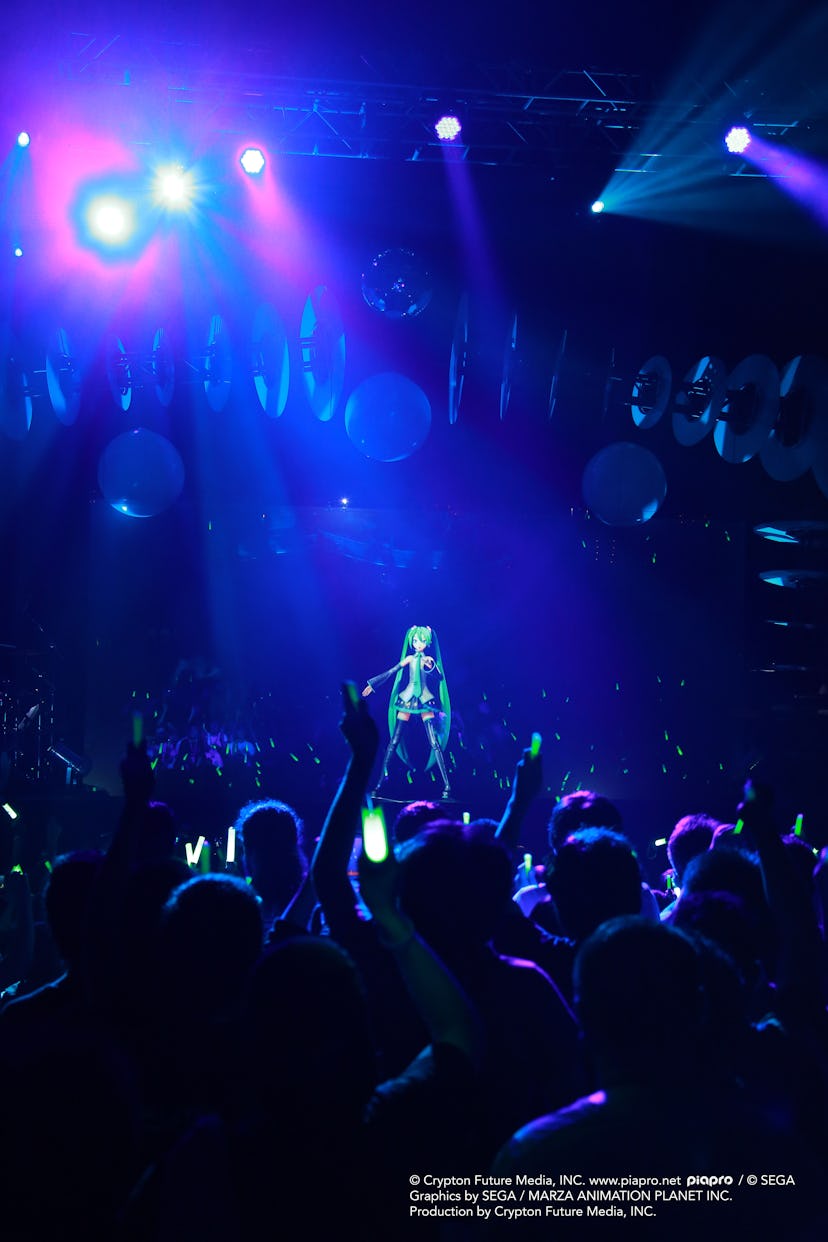What It’s Like to See a Hologram Perform “Live” In Concert
The Japanese virtual pop star Hatsune Miku — whose worked with Lady Gaga and Riccardo Tisci — comes to New York.

“Real people are so 2000.”
This was overheard outside the Hammerstein Ballroom in New York on a sweltering Saturday afternoon, where an all-ages crowd waited to see Hatsune Miku — the Japanese virtual pop star whose worked with everyone from Lady Gaga to Riccardo Tisci — perform a “live” show.
While the rest of New York fled elsewhere for Memorial Day Weekend, Miku’s diehard fans remained firmly planted on the sidewalk, lining up as early as 6:00 a.m. for an 8:00 p.m. sold-out show, which would be the last on the hologram’s tour. Many came dressed as Miku with neon blue pigtail wigs, knee-high black go-go boots, and French maid-like costumes. One boy wore a t-shirt that read: “It’s an anime thing, you wouldn’t understand.”
Many aspects of Hatsune Miku are difficult to wrap one’s head around, starting with the fact that she’s not a real person. Her character was first conceived of in 2007 by Crypton Future Media, a music distribution company based in Sapporo, Japan. Miku was the face of a software they developed that allowed users to generate their own songs, which she and a handful of other characters could then perform. Imagine if GarageBand and The Sims merged into one program.
Since Miku’s creation, over 170,000 songs have been made for her to sing, reaching over 100 million people on YouTube alone. She opened for Lady Gaga during her ArtPop tour in 2014, and she’s collaborated with Pharrell Williams on a remix of his song, “Happy.” She’s also worked with Nike, Google, Evian, Coca Cola, Sony, and Toyota. Most recently, fashion designers like Marc Jacobs and Givenchy’s Tisci have taken an interest as well, designing “custom” outfits for her. At the end of the day, Miku’s reach is endless because unlike real pop stars, she has no opinion and never gets tired.
It is for this reason that Miku’s fans are so devoted to her. One teenager in full costume told me that she loves Miku “because she never causes drama.” Miku will never have a meltdown and shave off her pigtails. She’ll never tweet something racist. She’ll never be photographed ripping a bong. She’ll be the sweet, innocent 16-year-old girl she is now, forever.
When I asked a seven-year-old named Poppy if she liked Miku because she was pretty she looked at me, confused. She likes Hatsune Miku because Hatsune Miku can do literally everything.
Upon entering a Hatsune Miku concert, fans are given two green glowsticks. “If you’ve provided your own glowsticks, please ensure that they are no longer than six-inches,” said a polite voice over the loudspeaker. (From where I was sitting, those who brought six-inch glowsticks were almost all men. Freudian slip, perhaps?)
Anamanaguchi, the electronic band comprised of real musicians with really bad hair, opened for Miku to get the crowd pumped. No one danced, however. Instead, the entire ballroom synchronized glowstick gestures to the beat of a thousand air drums.
One 15-year-old girl sitting next to me named Jessica energized before the show began with a bag of M&M’s the size of her head. She told me that she’d been waiting for this day for three years, and was sure it was going the be the best one in her entire life. She claimed to be a total “Weeaboo.” A wee-a-what? Apparently, this is the Japanese anime version of “goy.”
When the lights went down and Hatsune Miku materialized on stage, (right on time), she was crystal clear. I imaged she would be bigger, like the jumbo-tron versions of pop stars I’m used to seeing. But I could still make out her hair moving as she walked and the sparkle of her big blue eyes. She then proceeded to play the most viral song in her repertoire, not a word of which your average Weeaboo could understand. Jessica started wailing.
“Hello New York!” Miku said in a voice that sounded like a computerized baby coo. “It’s so nice to see everyone!” She waved and the crowd waved back, forgetting completely that she couldn’t actually see them. But they could see her, and that’s all that mattered.
“It’s like a wrestling match,” said a 20-something year old man after the show. “You know it’s fake, but the magic is real.” He’d been at the Hammerstein Ballroom since 11:00 a.m., so I believed him. Call me Weeaboo.
Watch W’s most popular videos here: